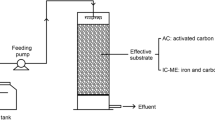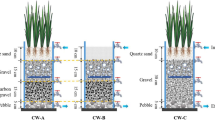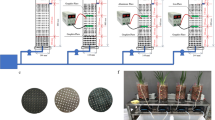Abstract
Sulfate wastewater has a wide range of sources and greatly harms water, soil, and plants. Iron-carbon microelectrolysis (IC-ME) is a potentially sustainable strategy to improve the treatment of sulfate (SO42−) wastewater by sulfate-reducing bacteria (SRB). In this study, an iron-carbon mixed micro-electrolysis bioreactor (R1), iron-carbon layered bioreactor (R2), activated carbon bioreactor (R3), and scrap iron filing bioreactor (R4) were constructed by up-flow column experimental device. The performance and mechanism of removing high-concentration sulfate wastewater under different sulfate concentrations, hydraulic retention times (HRT), and chemical oxygen demand (COD)/SO42− were discussed. The results show that the iron-carbon microelectrolysis-enhanced SRB technology can remove high-concentration sulfate wastewater, and the system can still operate normally at low pH. In the high hydraulic loading stage (HRT = 12 h, COD/SO42− = 1.4), the SO42− removal rate of the R1 reactor reached 98.08%, and the ORP value was stable between − 350 and − 450 mV, providing a good ORP environment for SRB. When HRT = 12 h and influent COD/SO42− = 1.4, the R1 reactor sulfate removal rate reached 96.7%. When the influent COD/SO42− = 0.7, the sulfate removal rate was 52.9%, higher than the control group. Biological community analysis showed that the abundance of SRB in the R1 reactor was higher than that in the other three groups, indicating that the IC-ME bioreactor could promote the enrichment of SRB and improve its population competitive advantage. It can be seen that the synergistic effect between IC-ME and biology plays a vital role in the treatment of high-concentration sulfate wastewater and improves the biodegradability of sulfate. It is a promising process for treating high-concentration sulfate wastewater.









Similar content being viewed by others
Data availability
The datasets used or analyzed during the current study are available from the corresponding author upon reasonable request.
References
Anandkumar B, George RP, Maruthamuthu S, Parvathavarthini N, Mudali UK (2016) Corrosion characteristics of sulfate-reducing bacteria (SRB) and the role of molecular biology in SRB studies: an overview. Corros Rev 34:41–63. https://doi.org/10.1515/corrrev-2015-0055
Barbusinski K, Kalemba K, Kasperczyk D, Urbaniec K, Kozik V (2017) Biological methods for odor treatment - a review. J Clean Prod 152:223–241. https://doi.org/10.1016/j.jclepro.2017.03.093
Byrne P, Wood PJ, Reid I (2012) The impairment of river systems by metal mine contamination: a review including remediation options. Crit Rev Environ Sci Technol 42:2017–2077. https://doi.org/10.1080/10643389.2011.574103
Chang Y, Chang Y, Hung C, Lee J, Liao H, Chou H (2014) Microbial community analysis of anaerobic bio-corrosion in different ORP profiles. Int Biodeterior Biodegrad 95:93–101. https://doi.org/10.1016/j.ibiod.2014.04.008
Chen Y, Wen Y, Zhou Q, Huang J, Vymazal J, Kuschk P (2016) Sulfate removal and sulfur transformation in constructed wetlands: the roles of filling material and plant biomass. Water Res 102:572–581. https://doi.org/10.1016/j.watres.2016.07.001
Cui X, Zhang M, Ding Y, Sun S, He S, Yan P (2022) Enhanced nitrogen removal via iron-carbon micro-electrolysis in surface flow constructed wetlands: selecting activated carbon or biochar? Sci Total Environ 815:152800. https://doi.org/10.1016/j.scitotenv.2021.152800
Demers I, Mbonimpa M, Benzaazoua M, Bouda M, Awoh S, Lortie S, Gagnon M (2016) Use of acid mine drainage treatment sludge by combination with a natural soil as an oxygen barrier cover for mine waste reclamation: laboratory column tests and intermediate scale field tests. Miner Eng 107:43–52. https://doi.org/10.1016/j.mineng.2016.11.017
Deng S, Li D, Yang X, Zhu S, Li J (2016) Process of nitrogen transformation and microbial community structure in the Fe(0)-carbon-based bio-carrier filled in biological aerated filter. Environ Sci Pollut Res 23:6621–6630. https://doi.org/10.1007/s11356-015-5892-6
Diao C, Ye W, Yan J, Hao T, Huang L, Chen Y et al (2023) Application of microbial sulfate-reduction process for sulfate-laden wastewater treatment: a review. J Water Process Eng 52:103537. https://doi.org/10.1016/j.jwpe.2023.103537
Dong Y, Guo Z, Di J et al (2023) Study on the effectiveness of sulfate reducing bacteria to remove heavy metals (Fe, Mn, Cu, Cr) in acid mine drainage. Sustainability 15:5486. https://doi.org/10.3390/su15065486
Evgenia I, Mika S (2013) The use of low-cost adsorbents for wastewater purification in mining industries. Environ Sci Pollut Res 20:7878–7899. https://doi.org/10.1007/s11356-013-1546-8
Feng Q, Guo W, Wang T, Alvarez LCM, Luo MM, Ge R, Zhou CR, Zhang Q, Luo JY (2021) Iron coupling with carbon fiber to stimulate biofilms formation in aerobic biological film systems for improved decentralized wastewater treatment: performance, mechanisms and implications. Bioresour Technol 319:124151. https://doi.org/10.1016/j.biortech.2020.124151
Filho JA, Azevedo A, Etchepare R, Rubio J (2016) Removal of sulfate ions by dissolved air flotation (DAF) following precipitation and flocculation. Int J Miner Process 149:1–8. https://doi.org/10.1016/j.minpro.2016.01.012
Gu S, Lian F, Yan K, Zhang W (2019) Application of polymeric ferric sulfate combined with cross-frequency magnetic field in the printing and dyeing wastewater treatment. Water Sci Technol 80:1562–1570. https://doi.org/10.2166/wst.2019.401
Guimaraes D, Leao VA (2014) Batch and fixed-bed assessment of sulphate removal by the weak base ion exchange resin Amberlyst A21. J Hazard Mater 280:209–215. https://doi.org/10.1016/j.jhazmat.2014.07.071
Guo G, Ekama GA, Wang Y, Dai J, Biswal BK, Chen G, Wu D (2019) Advances in sulfur conversion-associated enhanced biological phosphorus removal in sulfate-rich wastewater treatment: a review. Bioresour Technol 285:121303. https://doi.org/10.1016/j.biortech.2019.03.142
Han Y, Wu C, Fu X, Su Z, Liu M (2021) Sulfate removal mechanism by internal circulation iron-carbon micro-electrolysis. Sep Purif Technol 279:119762. https://doi.org/10.1016/j.seppur.2021.119762
Hao T, Xiang P, Mackey HR, Chi K, Lu H, Chui HK et al (2014) A review of biological sulfate conversions in wastewater treatment. Water Res 65:1–21. https://doi.org/10.1016/j.watres.2014.06.043
Iakovleva E, Mäkilä E, Salonen J, Sitarz M, Sillanpää M (2015) Industrial products and wastes as adsorbents for sulphate and chloride removal from synthetic alkaline solution and mine process water. Chem Eng J 259:367–371. https://doi.org/10.1016/j.cej.2014.07.091
Koschorreck M (2008) Microbial sulphate reduction at a low pH microbial sulphate reduction at a low pH. FEMS Microbiol Ecol 64:329–342. https://doi.org/10.1111/j.1574-6941.2008.00482.x
Kurniawan T, Chan G, Lo W-H, Babel S (2006) Physico–chemical treatment techniques for wastewater laden with heavy metals. Chem Eng J 118:83–98. https://doi.org/10.1016/j.cej.2006.01.015
Lennicke C, Cocheme HM (2021) Redox metabolism: ROS as specific molecular regulators of cell signaling and function. Mol Cell 81:3691–3707. https://doi.org/10.1016/j.molcel.2021.08.018
Li B, Lv R, Xiao Y, Zhang J, Mai Y, Lin L (2020) Effect of metal ions on nitrite degradation by Acinetobacter oleophilus YT03. Chinese J Fish 33:53–59
Li H, Di J, Dong Y, Bao S, Fu S (2023) Dynamic experiment on remediation of acid mine drainage by iron-carbon microelectrolysis enhancing sulfate-reducing bacteria. Environ Sci Water Res Technol 9:1413–1425. https://doi.org/10.1039/D2EW00947A
Liang F, Xiao Y, Zhao F (2013) Effect of pH on sulfate removal from wastewater using a bioelectrochemical system. Chem Eng J 218:147–153. https://doi.org/10.1016/j.cej.2012.12.021
Lin H, Li Z, He Y, Dong Y, Li B (2019) Research progress on treatment of acid mine wastewater by sulfate reducing bacteria. Environ Prot Sci 45:25–31. https://doi.org/10.16803/j.cnki.issn.1004-6216.2019.05.006
Ma D, Wen C, Ji M (2013) Microelectrolysis-iron-carbon internal electrolysis coupling pretreatment of high concentration dye wastewater. Chem Ind Eng Prog 32:205–208
Meng D, Hui Z (2022) Multi-agent evolutionary game in the recycling utilization of sulfate-rich wastewater. Int J Environ Res Public Health 19:8770. https://doi.org/10.3390/ijerph19148770
Miao Y, Qi S, Chen J, Wang J, Tian B, Xin B (2021) Application of sulfate reducing bacteria in acid mine wastewater treatment. Appl Chem Ind 50:3074–3078. https://doi.org/10.16581/j.cnki.issn1671-3206.20211105.008
Mizuno O, Li YY, Noike T (1998) The behavior of sulfate-reducing bacteria in acidogenic phase of anaerobic digestion. Water Res 32:1626–1634. https://doi.org/10.1016/S0043-1354(97)00372-2
Marchal R, Chaussepied B, Warzywoda M (2001) Effect of ferrous ion availability on growth of a corroding sulfate-reducing bacterium[J]. Int Biodeterior Biodegrad 47(3):125–131. https://doi.org/10.1016/S0964-8305(01)00038-5
Peng Z, He H, Yang C, Zeng G et al (2017) Biological treatment of wastewater with high concentrations of zinc and sulfate ions from zinc pyrithione synthesis. Trans Nonferrous Met Soc China 27:2481–2491. https://doi.org/10.1016/S1003-6326(17)60275-9
Shen Y, Zhuang L, Zhang J, Fan J, Yang T, Sun S (2019) A study of ferric-carbon micro-electrolysis process to enhance nitrogen and phosphorus removal efficiency in subsurface flow constructed wetlands. Chem Eng J 359:706–712. https://doi.org/10.1016/j.cej.2018.11.152
Silva R, Cadorin L, Rubio J (2010) Sulphate ions removal from an aqueous solution: I. Co-precipitation with hydrolyzed aluminum-bearing salts. Miner Eng 23:1220–1226. https://doi.org/10.1016/j.mineng.2010.08.016
Sun S, Gu X, Zhang M, Tang L, He S, Huang J (2021) Biological iron nitrogen cycle in ecological floating bed: nitrogen removal improvement and nitrous oxide emission reduction. Environ Pollut 268:115842. https://doi.org/10.1016/j.envpol.2020.115842
Tsukamoto T, Killion H, Miller G (2004) Column experiments for microbiological treatment of acid mine drainage: low-temperature, low-pH and matrix investigations. Water Res 38:1405–1418. https://doi.org/10.1016/j.watres.2003.12.012
Wang A, Ren N, Liu W, Huang Z, Zhen W (2001) The function and status of SRB population in acidogenic desulfurization reactor. China Environ Sci 2:24–28
Wang L, Wang Y, Ma F, Tankpa V, Bai S, Guo X, Wang X (2019) Mechanisms and reutilization of modified biochar used for removal of heavy metals from wastewater: a review. Sci Total Environ 668:1298–1309. https://doi.org/10.1016/j.scitotenv.2019.03.011
Wei C, Wang W, Deng Z, Wu C (2007) Characteristics of high-sulfate wastewater treatment by two-phase anaerobic digestion process with Jet-loop anaerobic fluidized bed. J Environ Sci 19:264–270. https://doi.org/10.1016/S1001-0742(07)60043-6
Xia X, Zhu F, Li J, Yang H, Wei L, Li Q, Jiang J, Zhang G, Zhao Q (2020) A review study on sulfate-radical-based advanced oxidation processes for domestic/industrial wastewater treatment: degradation, efficiency, and mechanism. Front Chem 8:592056. https://doi.org/10.3389/fchem.2020.592056
Xie R, Wu M, Qu G, Ning P, Cai Y, Lv P (2018) Treatment of coking wastewater by a novel electric assisted micro-electrolysis filter. J Environ Sci 66:165–172. https://doi.org/10.1016/j.jes.2017.05.034
Xu S, Zhang D, Wu M, Xiao L (2018) Application of sulfate reducing bacteria in treatment of acid mine drainage. Nonferrous Metals Sci Eng 9:92–97. https://doi.org/10.13264/j.cnki.ysjskx.2018.01.016
Yang W, Vollertsen J, Hvitved-Jacobsen T (2005) Anoxic sulfide oxidation in wastewater of sewer networks. Water Sci Technol 52:191–199. https://doi.org/10.2166/wst.2005.0076
Yang Z, Ma Y, Liu Y, Li Q, Zhou Z, Ren Z (2017) Degradation of organic pollutants in near-neutral pH solution by Fe-C micro-electrolysis system. Chem Eng J 315:403–414. https://doi.org/10.1016/j.cej.2017.01.042
Zhang J, Zhang Y, Quan X, Liu Y, An X, Chen S, Zhao H (2011) Bioaugmentation and functional partitioning in a zero valent iron-anaerobic reactor for sulfate-containing wastewater treatment. Chem Eng J 174:159–165. https://doi.org/10.1016/j.cej.2011.08.069
Zhao Z, Chun Z, Yang Y (2022) A review of sulfate-reducing bacteria: metabolism, influencing factors and application in wastewater treatment. J Clean Prod 376:134109. https://doi.org/10.1016/j.jclepro.2022.134109
Funding
The project is funded by the National Natural Science Foundation of China (41672247), Liaoning Province’s “Program for Promoting Liaoning Talents” (XLYC1807159), the Discipline Innovation Team of Liaoning Technical University (LNTU20TD-21), and Liaoning Provincial Department of Education Project (LJKZ0324).
Author information
Authors and Affiliations
Contributions
Hanzhe Li and Junzhen Di conceived and designed the experiments. Hanzhe Li and Yanrong Dong performed the experiments. Hanzhe Li and Sihang Bao analyzed the data. Hanzhe Li and Saiou Fu wrote the manuscript. All authors read and approved the final manuscript.
Corresponding author
Ethics declarations
Ethics approval
Not applicable.
Consent to participate
Not applicable.
Consent for publication
All authors have read this manuscript and consent for publication in Environmental Science and Pollution Research.
Competing interests
The authors declare no competing interests.
Additional information
Responsible Editor: Gerald Thouand
Publisher's Note
Springer Nature remains neutral with regard to jurisdictional claims in published maps and institutional affiliations.
Rights and permissions
Springer Nature or its licensor (e.g. a society or other partner) holds exclusive rights to this article under a publishing agreement with the author(s) or other rightsholder(s); author self-archiving of the accepted manuscript version of this article is solely governed by the terms of such publishing agreement and applicable law.
About this article
Cite this article
Li, H., Di, J., Dong, Y. et al. Enhanced reduction of sulfate by iron-carbon microelectrolysis: interaction mechanism between microelectrolysis and microorganisms. Environ Sci Pollut Res (2024). https://doi.org/10.1007/s11356-024-32993-9
Received:
Accepted:
Published:
DOI: https://doi.org/10.1007/s11356-024-32993-9




